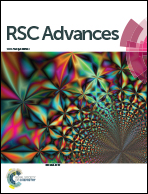Facile one pot synthesis of mesoporous organic–inorganic hybrid aluminosilicate spheres with ultra-high aluminium contents and their enhanced adsorption behavior for methylene blue†
Abstract
Hybrid mesoporous organo-aluminosilicate spheres (HMAS) with ultra-high aluminium contents have been successfully synthesized with co-condensation of sodium aluminate and organosilane at room temperature using cetyltrimethyl-ammonium bromide (CTAB) as a templating agent. The hybrid framework remains intact after template removal with mild acidity solutions, and the template-extracted samples have a high content of framework aluminium and textural porosity. Additionally, the high Al-containing hybrid mesoporous materials exhibit excellent removal performance for methylene blue (397 mg g−1) owing to their extremely low Si/Al ratio and high surface area.


 Please wait while we load your content...
Please wait while we load your content...